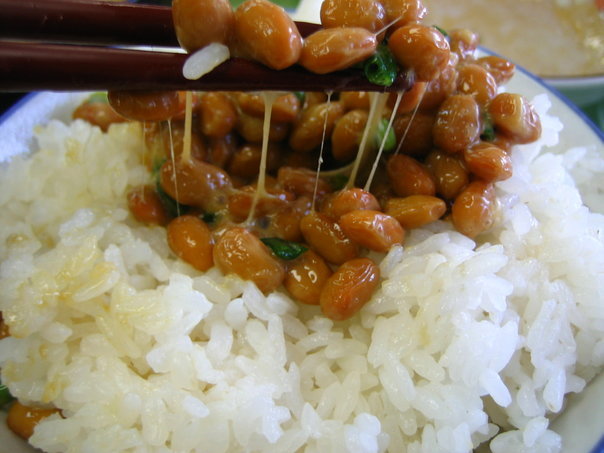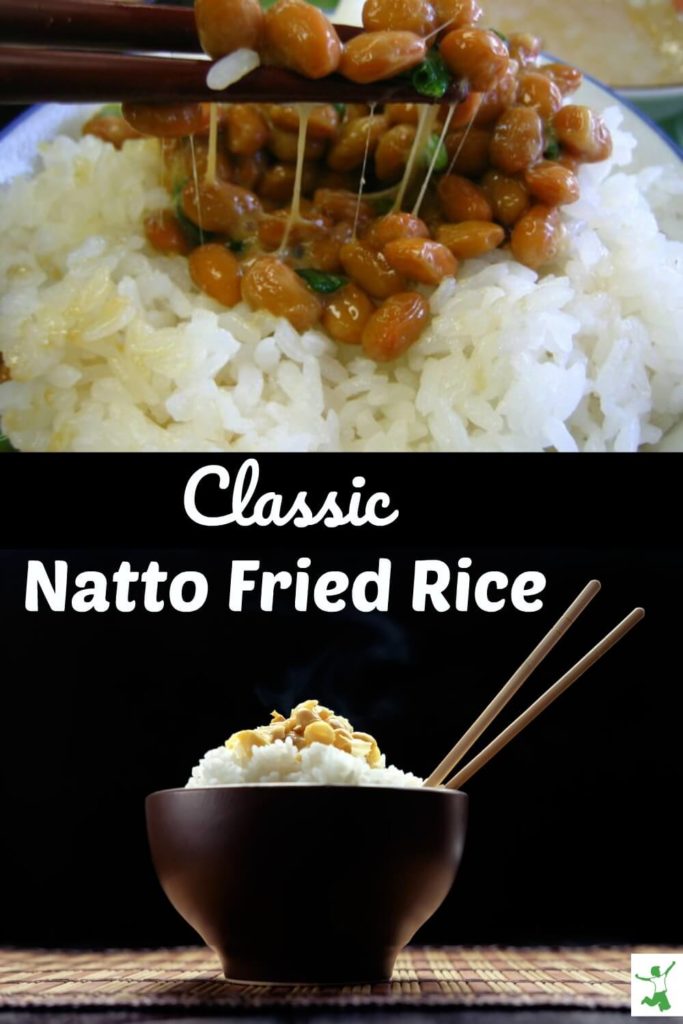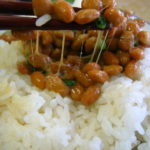 It’s very exciting to see the growing interest of people from all walks of life in traditional foods like natto.
It’s very exciting to see the growing interest of people from all walks of life in traditional foods like natto.
Even a family on food stamps can typically afford it, as it’s one of the most budget friendly as well as nutritious foods on the planet.
Natto is a form of fermented soybean that, at least in my local area, is only available at Asian supermarkets in the frozen section.
You will be surprised at how such a little container goes a very long way!
Including natto with a simple and very cheap meal of fried rice turns the meal into a powerhouse of nutrition in the form of vitamin K2, the elusive Activator X written about by Dr. Weston A. Price. He found via years of research that this frequently overlooked nutrient is the secret sauce responsible in large part for the vibrant health of Traditional Societies.
Natto is rich in Vitamin K2 which supercharges mineral absorption in the body and boosts the effectiveness of the other fat soluble vitamins, most notably A and D.
Natto Fried Rice
The problem with natto is that the smell, taste and texture can be quite challenging to get used to. Hiding it in a dish of fried rice is therefore the best way to go to successfully include it in the diet on a frequent basis.
The following recipe for natto fried rice is a modification of the one found in the book Vitamin K2 and the Calcium Paradox by Dr. Kate Rheaume-Bleue, Bsc., ND. Without a doubt, it is one of the best books I’ve read on this subject.
Please note that you cannot substitute tempeh or tofu for the natto. The fermentation of natto is what produces the high amounts of Vitamin K2 (in the form of MK7). Other forms of soybeans do not contain this nutrient in such large amounts if at all.


Natto Fried Rice Recipe
Easy recipe for natto fried rice that is a highly nutritious as well as an extremely low cost meal that will supply elusive and critical nutrients to your diet.
Ingredients
- 2 containers Non-GMO natto thawed
- 4 eggs beaten
- 4 Tbl expeller pressed coconut oil
- 2 tsp sesame oil
- 4 cups leftover cooked rice cold, straight from the refrigerator is best
- 1 bunch green onions chopped
- soy sauce traditionally brewed, nonGMO
Instructions
-
In a bowl, stir natto briefly to thicken. Mix in beaten eggs.
-
Add 2 TBL coconut oil to a frypan and coat the surface evenly. Mix in sesame oil, turn the burner on medium and let heat for 1 minute.
-
Add the egg/natto mixture and saute until the egg is completely cooked. Remove egg/natto mixture from the pan and set aside.
-
Add another 2 TBL of coconut oil to the frypan and add handfuls of the cold, cooked rice working out the lumps with your fingers.
-
Saute the rice until hot and then add the chopped green onions or peas. Saute for a minute or two until hot and then add the egg and natto mixture to the pan as well.
-
Once the entire dish is hot, serve natto fried rice immediately and season to taste at the table with the unpasteurized soy sauce.
-
Refrigerate any natto leftovers.
Recipe Notes
White, brown or even wild rice may be used as the base for this natto recipe. This article on the benefits of white rice vs brown contains more information. Wild rice is the most nutritious.
1 cup frozen peas may be substituted for the green onion.








My husband and I plan on moving to Japan soon – probably within the next year – and I’ve been very interested in trying Japanese foods. (besides sushi) Thanks for the recipe, although now I’m a little bit scared of it after reading the comments 😉 I’ll try anything once, though! If I can handle balut in the Philippines surely I can manage some natto.
I’m with Stanley, I’d rather eat gouda, grass-fed butter and liver than ever eat natto again (yes, I’ve tried it.)
I have been avoiding soybean and any products that contains it like the plague because of the aluminum content due to the genetically modified seed. Do we know where the Natto soybean comes from? If you make it yourself, aren’t you most likely to get the genetically modified version?
Sarah,
Is this recipe with the Rice in it? I have had Diabetes before. What about the person with Celiac?
Yeah Sarah! I remember your other post about natto and the fact that I lived in Japan for fourteen years and never grew to like natto made me give it another try. Yum! My Japanese ex-husband told me that you can make your own natto cheaply by cooking up soybeans and mixing them with part of a container of natto. I tried it and let it incubate in my oven with the light on and 24 hours later we had natto. Save a portion to make the next batch. The cooked soybeans have to be hot for the culture to ferment. Try it!
do you use toasted sesame oil or plain sesame oil in the recipe.
Either one. I prefer toasted but some folks find the flavor rather strong.
The toasted sesame oil is also better for covering up the taste of the natto! LOL
Does miso confer the same benefit as natto does? I cannot find natto in a 50-mile radius but am able to get miso over the interwebs.
No, miso has very little K2 in in. Although, miso is wonderful and I do use it in my cooking.
Love the Nutrient Dense Meal on the Cheap!!!!! Please send more!!!!! These are so important!
Sometimes you can find natto at sushi places; I’ve had it with a raw quail egg and toasted nori. I really like it with a little umeboshi plum.The restaurant fermented their own soybeans so it was really fresh and there was almost no smell at all! Anyone have any ideas on how to ferment the soy beans and make natto from scratch?
you can find recipes for making natto on the internet. It seems fairly simple. I am getting ready to try it myself.
I have begun eating natto daily. It is a challenge for sure! And I am an adventurous eater! I chop up green onion on top of a little natto and pour a little bone broth over it, add a few pieces of nori and some celtic salt and just go for it. It is getting easier after a few weeks. Yesterday I introduced a friend to natto. She is not an adventurous eater at all but she was interested in all the health benefits. I was sure she would gag. She stirred it up with the little packets of seasoning and took a big mouthful and said she liked it! And ate the whole thing!
I am wondering if cooking the natto destroys some of the health benefits (just like cooking yogurt or kefir or cultured vegetables) since it is a live fermented food. I have read how many people just add it to hot rice but do not cook it first.
No, cooking natto does not destroy any K2!!!!! Yippie!